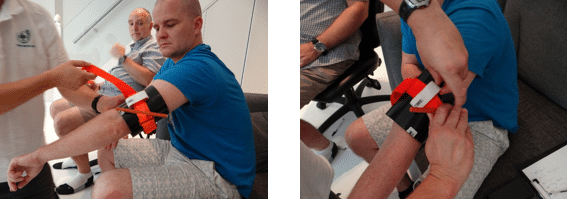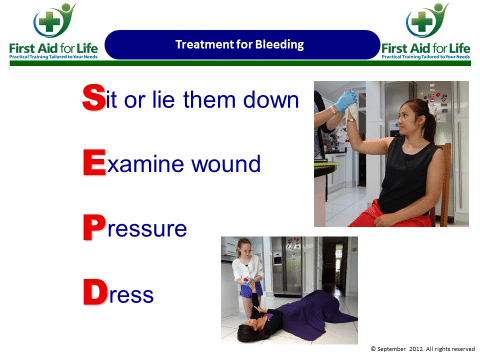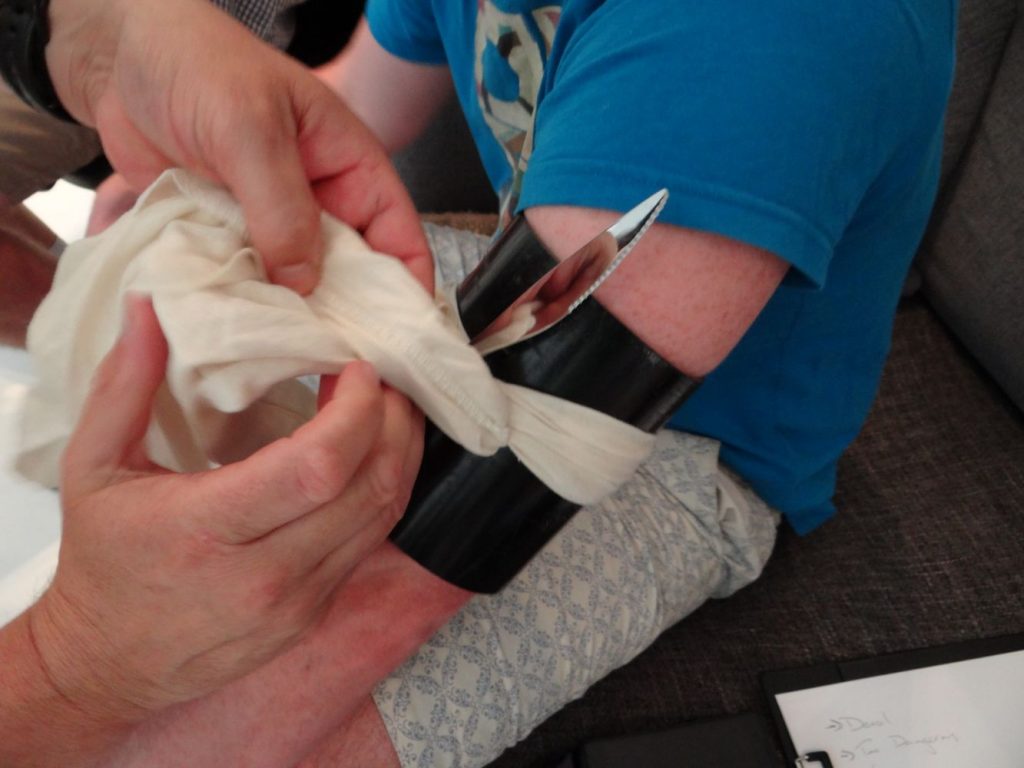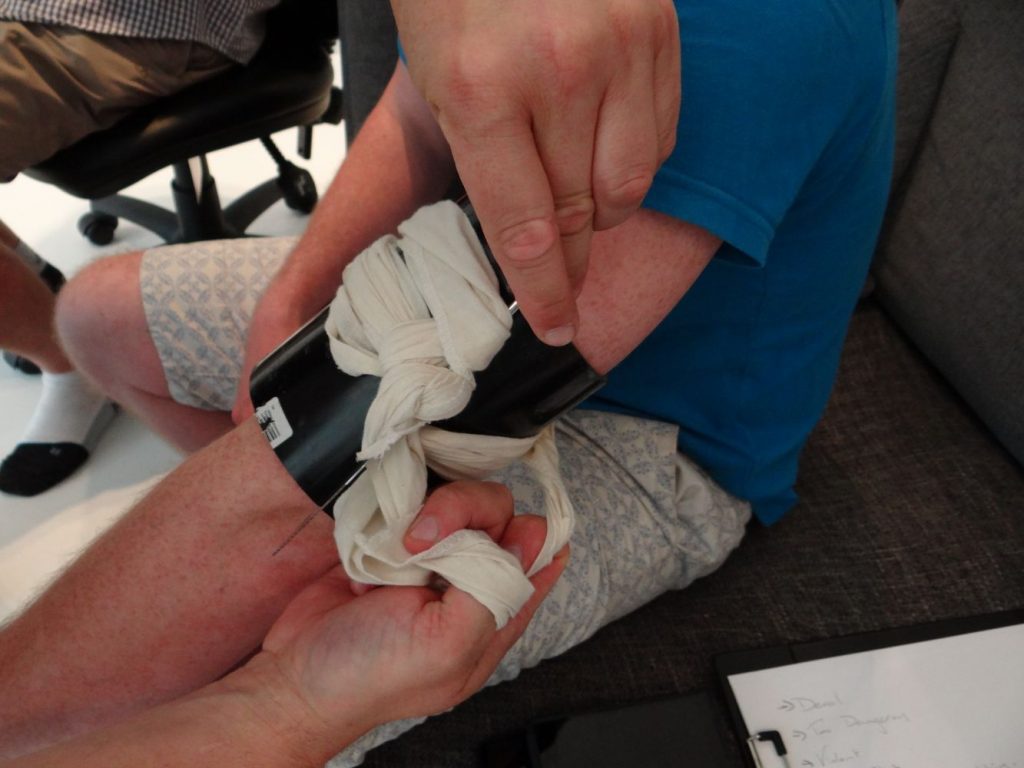
The European Resuscitation Council (ERC) First Support Pointers 2015 state that when direct stress can not management extreme bleeding, tourniquets and haemostatic dressings at the moment are suggested. ILCOR (Worldwide Liaison Committee on Resuscitation) totally helps this
If somebody is bleeding extraordinarily closely from both a serious artery or vein, they will rapidly lose a number of blood. The bleeding is more likely to pulsate in time with the guts. That is extra pronounced with an arterial bleed, however occurs inside venous bleeds too. With extraordinarily heavy, probably catastrophic bleeding an grownup might simply lose 40% of their blood quantity in 3-4 minutes. This might be even faster when coping with kids.
If a casualty loses a considerable quantity of blood – greater than 40% of their blood quantity, the physique is now not in a position to compensate for that quantity of blood loss. They’ll develop hypovolaemic shock. Hypovolaemic shock is a low quantity of blood inflicting failure of the circulatory system, if untreated they may die.
Navy and civilian analysis has proven wealth of proof demonstrating the effectiveness of tourniquets and haemostatic dressings within the remedy of life-threatening bleeding.
Key modifications within the new European Resuscitation Pointers referring to bleeding:
- New pointers now not advocate elevation for the management of extreme bleeding. Elevation does scale back the stream of blood, however alone it won’t cease bleeding. If somebody has an arterial bleed, simply holding it within the air shouldn’t be going to cease the bleeding. Making use of direct stress to the supply of bleeding is more likely to cease life-threatening blood stream.
- You shouldn’t use oblique stress factors to manage extreme bleeding. There may be multiple artery supplying the blood to every limb. Urgent on stress factors won’t be able to cease the blood stream. Discovering stress factors will also be very tough, notably with the femoral artery.
Remedy of Bleeding:

- Encourage the casualty to sit down or lie down in probably the most applicable place for the situation of the wound and the quantity of blood misplaced. If they’re feeling dizzy and exhibiting early indicators of shock, increase their legs.
- Study the wound (as rapidly as doable) to evaluate:
- The sort and extent of bleeding.
- The supply of the bleeding.
- Whether or not there are any overseas objects within the wound – if that’s the case, don’t take away them as they are going to be stemming bleeding, however apply direct stress both aspect of the thing.
- Apply direct stress to try to management bleeding. In the event you management the bleeding with this direct stress, hold holding for 10 minutes because it takes this lengthy for clots to kind.
- When you management bleeding, gown the wound – if the wound bleeds by way of the primary dressing, apply one other on prime. If the wound bleeds by way of the second dressing it is best to think about different choices to cease the bleeding.
Step one when treating a catastrophic bleed is all the time to use direct stress. It’s nonetheless more likely to be the primary and solely answer wanted for the casualty.
Please be aware:
Tourniquets and haemostatic dressings have been launched as further choices to deal with extreme catastrophic bleeding. Nevertheless, direct stress stays the primary selection of remedy and it’ll management bleeding within the overwhelming majority of instances. The European Resuscitation Council 2015 pointers state that haemostatic dressings and tourniquets needs to be used when direct stress is both not doable or ineffective.
In environments the place a catastrophic bleed is probably going, tourniquets and haemostatic dressings needs to be an integral a part of the primary support equipment. All first aiders ought to know find out how to use tourniquets.
As a member of most people you’re extremely unlikely to want to make use of a tourniquet. Nevertheless understanding find out how to improvise one, and the way and when to make use of one, might save lives if you happen to’re ever concerned in a serious medical accident or emergency.
Do Improvised Tourniquets Work?
There may be ongoing debate across the usefulness of an improvised tourniquet: Stewart SK, Duchesne JC, Khan MA mentioned this of their paper – Improvised Tourniquets: out of date or compulsory: Journal of Trauma Acute Care Surg 2014;78;1. He got here to the next conclusion:
“We suggest that training on find out how to expertly assemble and apply an improvised tourniquet turns into and integral a part of fundamental life assist and pre-hospital emergency care algorithms, for navy and civilians alike. Within the absence of a commercially produced tourniquet, this easy first support measure can satisfactorily arrest life-threatening haemorrhage, whereas minimizing morbidity that different cruder designs might trigger.”
The best way to Use an Improvised Tourniquet
Right here is among the best methods to make an improvised tourniquet from the contents of a typical first support equipment. Use a triangular bandage folded right into a broad fold bandage and to tighten the tourniquet utilizing scissors as a windlass. You probably have entry to cutlery, similar to a desk knife, this might be even higher. In any other case you now not have your scissors obtainable to make use of.
Please be aware: A tourniquet needs to be a minimum of 4cm extensive to forestall localised harm to nerve tissues.
- Tie the bandage as rapidly and tightly as doable across the naked limb.
- The tourniquet needs to be 5-7cm above the wound. By no means place a tourniquet over a joint.
- Tighten the tourniquet till the life-threatening bleeding stops. This will likely be extraordinarily painful to the casualty, clarify to the casualty that that is very important to avoid wasting their life.
- If the bleeding won’t cease; attempt tightening the tourniquet additional or apply a second above the primary one. Slight bleeding should proceed, however the life- threatening bleeding needs to be managed.
- Guarantee somebody has referred to as 999/112 for assist.
- Notice the precise time of the applying and write this prominently on the tourniquet if doable.
- NEVER launch the tourniquet your self. This could solely be accomplished by a healthcare skilled in a managed atmosphere.
If there’s a clear lower by way of an artery, for instance in a deep incised wound, the artery might contract again up the arm or leg. This is the reason it is best to place the tourniquet a minimum of 5cm (or 2 inches) above the wound.
It’s possible you’ll discover different steerage on the positioning of a tourniquet, similar to making use of the primary tourniquet mid-point over a single bone. This recommendation can also be acceptable, as long as you place the tourniquet proximal to the wound (nearer to the trunk of the physique). Earlier recommendation was that tourniquets might solely be positioned on single bones. It’s now identified that this isn’t the case and tourniquets needs to be positioned on decrease limbs, if that’s the place the wound is.
1. Place the knife or your scissors on prime of the knot and tie one other knot on prime of them.

2. Use the knife or your scissors as a windlass to wind spherical and tighten the tourniquet.

3. The windlass could be secured both by tying one other triangular bandage to cease it unwinding or by wrapping and tying each ends of the triangular bandage across the ends of the windlass to make sure it stays in place.

Time Issue
It is very important be aware the precise time during which you utilized the tourniquet. To rearrange for pressing switch for medical assist, make sure you inform them the place and when the tourniquet was utilized.
Please be aware it is going to be extraordinarily painful for the casualty to have a tourniquet. Howewver it’s completely very important that you just apply the tourniquet tight sufficient to completely cease the bleeding.
If a tourniquet shouldn’t be on tight sufficient it may possibly make issues worse as it may possibly occlude the veins. Arteries could also be more durable to cease as they’re much less straightforward to get to. Furthermore, if the venous return is stopped by the tourniquet, the one place for blood to return out is from the wound.
NEVER be tempted to loosen or take away a tourniquet. As soon as utilized, the removing of tourniquets ought to solely ever be accomplished by a physician in a managed setting.
Unsuitable however Tempting Alternate options for an Improvised Tourniquet:
A tie is more likely to be too skinny. A leather-based belt can also be unsuitable as it’s too powerful to make use of with a windlass; you can be unable to supply enough pressure by hand to tighten it sufficiently to supply sufficient stress to cease the blood stream.
A tourniquet needs to be a minimum of 4cm extensive to forestall localised harm to nerves tissues.
It’s essential to apply the tourniquet sufficiently tightly to cease the bleeding. If it isn’t tight sufficient it may possibly truly find yourself growing blood loss. It could be vital to use multiple tourniquet to fully cease bleeding.
It is necessary for the physician treating the casualty to have a very good understanding of how lengthy the tourniquet has been utilized for. Write the time the tourniquet was utilized onto the tourniquet itself or onto the casualty.
Please keep in mind that though tourniquets can save lives, their use shouldn’t be taken evenly. They continue to be a second-line remedy when direct stress shouldn’t be doable or inadequate to manage bleeding.
About us
First Support for Life present award-winning first support coaching tailor-made to your wants. Please go to our web site and be taught extra about our sensible and on-line programs. It’s vital to maintain your expertise present and refreshed. We’re at present offering important coaching for people and teams throughout the UK. As well as, we’ve an amazing vary of on-line programs. These are ultimate as refreshers for regulated {qualifications} or as Appointed Individual {qualifications}.
You possibly can attend a totally regulated Sensible or On-line First Support course to know what to do in a medical emergency. Please go to https://firstaidforlife.org.uk or name 0208 675 4036 for extra details about our programs.
First Support for Life is a multi-award-winning, totally regulated first support coaching supplier. Our trainers are extremely skilled medical, well being and emergency providers professionals who will tailor the coaching to your wants. Programs for teams or people at our venue or yours.
First Support for all times supplies this data for steerage and it isn’t in any manner an alternative to medical recommendation. We’re not accountable or answerable for any prognosis made, or actions taken on this data.





